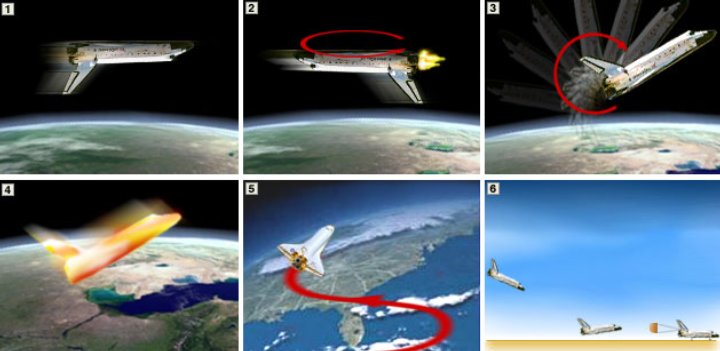NASA Space Shuttle Re-entry
(started from an article published by BBC News in December 2006)
To return to Earth the space shuttle must make a series of complicated manouevres to align itself into the correct position to achieve a safe descent:

-
About 70 minutes before touchdown, the actions that commit the orbiter to re-entry are taken. Until this point, it's in stable orbit at an altitude of some 150 km and a velocity a little over 29,000 km/h (Mach 25). The attitude of the craft is nose-first and belly-up (i.e. topside facing the Earth). A speed trim of about 300 km/h will be sufficient to initiate descent.
-
To re-enter the atmosphere, the shuttle is turned tail first to the direction of travel, and fires its engines for about 20 seconds to slow its speed.
-
The orbiter is then flipped the right way up in order to enter the atmosphere with its ceramic tiles-covered belly facing downward.
-
At around 35 minutes before touchdown and at an altitude of around 120 km, the orbiter enters a discernable atmosphere. Though still extremely rarefied (containing little oxygen), there is now enough external matter to undergo ionisation, and the plasma flare begins to form. The distance to the landing site is about 8,000 km. From this point, the angle of attack is critical, and is maintained at 40 degrees by automatic and continuous thruster trims. Any shallower, and the orbiter will experience excessive lift and overfly its destination. Any steeper, and it will burn up.
-
At an altitude of 85 km, the flight surfaces of the orbiter become usable. Under automatic control, a series of 4 S-bend turns is now performed, with the craft banking through 80 degrees at the fullest extent of the roll. The object is to lose speed more quickly.
It's now 20 minutes to touchdown, and the plasma shroud is at its most intense. This is the hottest phase of re-entry.
-
10 minutes before touchdown, the orbiter is still 40 km up, and its speed is still nearly 10,000 km/h (Mach 8). The peak skin temperature, on the underside of the wings close to the leading edges, is around 1,600 C - hot enough to melt steel. Plasma flaring has ceased and has now been replaced by reactive hypersonic flow. Drag on the craft increases greatly, and deceleration takes place more rapidly. The pilot will now be ready to take over control as the speed drops below 4,000 km/h (Mach 3) and into a stable supersonic regime. For the first time, the vehicle is pitched forward so that the nose is pointing downwards. Conventional flight surfaces now become effective, such as the air brakes which can be applied through the fantail configuration of the orbiter's rudder.
At about 40 km from the runway, the pilot begins to adjust the heading. The descent is aggressive: 90 seconds from touchdown, the altitude is still around 4,000 m, and for the next minute the orbiter will lose height about 20 times quicker than would a commercial airliner. At 600 metres and 30 seconds from landing, the pilot pulls up the nose once more and deploys the landing gear.
The speed at touchdown is 350 km/h. The rear wheels come down first, and a parachute is released to slow the vehicle - it has no means through which to exert reverse thrust. The orbiter's wheel-brakes are progressively applied. As the speed falls to about 150 km/h, the nose-wheel touches down and full braking is employed. The parachute is jettisoned just before the craft rolls to a complete stop, somewhat more than two kilometres from its point of touchdown.

